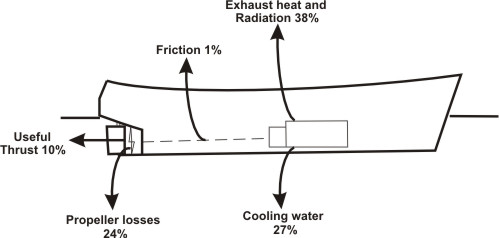Sources of Energy Inefficiency
By Manuel Paez
In addressing the problem of energy efficiency it is useful to understand
just where the energy is expended in a fishing vessel and what aspects of this
can be influenced by the operator, boatbuilder or mechanic.
In a small slow-speed vessel, the approximate distribution of energy created
from the burning of fuel is shown in figure below.

Energy losses in a small trawler
Only about one-third of the energy generated by the engine reaches the propeller
and, in the case of a small trawler, only one-third of this is actually spent on
useful work such as pulling the net.
In a vessel that does not pull a net or dredge, of the energy that reaches the
propeller:
• 35 percent is used to turn the propeller;
• 27 percent to overcome wave resistance;
• 18 percent to overcome skin friction;
• 17 percent to overcome resistance from the wake;
• 3 percent to overcome air resistance.
So, where can gains be made, or at least losses minimized?
Engine. Most of the energy generated by the fuel burnt in the engine is lost as
heat via the exhaust and cooling system, and unfortunately there is not a lot
which the operator can do to usefully recuperate this energy. In certain cases,
some of this can be regained through the use of a turbocharger but, in general,
the thermal efficiency of small higher-speed diesel engines is low and little
can be done to improve this. However, some engines are significantly more
fuel-efficient than others (especially among different types of outboard
motors).
Propeller. The energy lost in turning the propeller is controlled by two
principle factors - the design of the propeller (how well suited it is to the
engine, gearbox, hull and fishing application) and its condition.
These factors can be influenced by the vessel operator:
Mode of operation. The effect of wave resistance, although determined
principally by the dimensions and form of the vessel, increases dramatically
with speed. Significant fuel savings can be made by maintaining a reasonable
speed for the hull, irrespective of vessel type.
Fishing operations also influence energy consumption and efficiency through gear
technology and operating patterns, particularly trip length. Neither of these
are particularly easy to change in practice.
Hull maintenance. The significance of skin friction is controlled principally by
the quality of the hull's finish - hull roughness as well as the amount of weed
and marine growth that is allowed to accumulate on the hull. Both of these
factors are under the direct influence of the operator's maintenance programme
but, depending on the type of vessel and fishery, a significant expenditure on
hull finish is not always worthwhile.
Reference:
FAO - Food and Agriculture Organization
of the United Nations
FAO FISHERIES TECHNICAL PAPER 383
|

